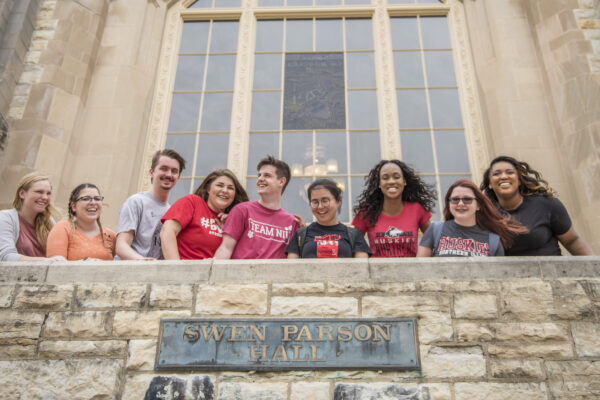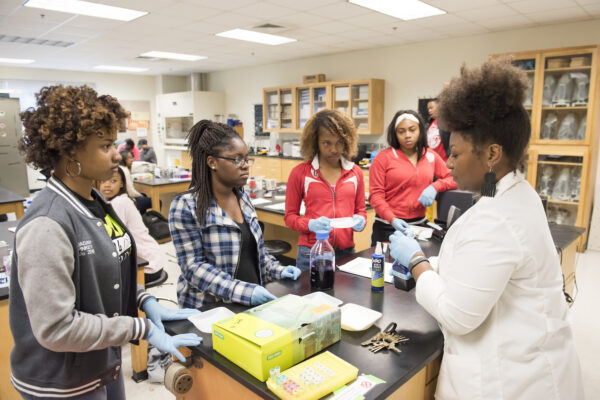This blog is part of a series highlighting the findings from Pulling Back the Curtain: Enrollment and Outcomes at Minority Serving Institutions.
Higher education as a whole can learn valuable lessons from minority serving institutions (MSIs), especially when we reflect on how to help college students succeed. As many of us in education know, an ongoing challenge for colleges and universities is creating learning environments that contribute to student achievement. While it is expected that institutions will work to help all of their students succeed, it is equally important that they have a depth of understanding of their student populations in order to provide tailored support for their success.
The Asian American Pacific Islander (AAPI) student population no exception. The AAPI population is one that requires considerable attention given its size and complexity. It is composed of over 48 ethnicities that are diverse in socioeconomic class, language, religion, educational attainment, and migration history, among other attributes. AAPIs are also one of the fastest-growing minority groups in the United States, with a predicted population increase of 125 percent (to over 40.1 million) by 2060.
Given these increasing numbers and the complex, heterogeneous composition of the AAPI population, higher education institutions must have a deeper understanding of AAPI students and their needs. One such opportunity is to consider the role of Asian American and Native American Pacific Islander-Serving Institutions (AANAPISIs) and their contributions to the success of AAPI college students.
Findings from a recent ACE report provide a more complete picture of these contributions. Analyzing data from the National Student Clearinghouse (NSC), the authors found that the majority of students at public AANAPISIs attend through mixed enrollment, moving between full time and part time, while the majority of students at private four-year AANAPISIs enroll exclusively full time.
Across all sectors, exclusively full-time students (the cohort most similar to that used to calculate federal graduation rates) at AANAPISIs complete at higher rates than what the federal graduation rate shows, primarily because NSC data follow student movement across institutions and states. For example:
- The NSC total completion rate for exclusively full-time students at public four-year AANAPISIs was 87.9 percent, compared to the federal graduation rate of 66.2 percent.
- Exclusively full-time students at private four-year AANAPISIs had a completion rate of 93.2 percent, higher than that of the federal rate of 81.0 percent.
- At public two-year AANAPISIs, exclusively full-time students have a four-year completion rate of 42.6 percent, compared to the federal four-year completion rate of 27.9 percent.
A Closer Look at AAPI Students
AAPI students are often excluded within the larger national discussion on the needs of racial and ethnic minorities in higher education. Among the many possible reasons for this exclusion is the common misperception that AAPIs are high achieving, a belief long known as the model minority myth. This misperception has grave consequences for AAPI college students. Student affairs professionals, for instance, may limit outreach efforts and services, such as tutoring or psychological services. We may also see this play out in federal or local grant and scholarship programs geared toward racial and ethnic minorities where AAPI students are not, for the most part, considered underrepresented. These students often are not afforded the opportunity to take advantage of these financial resources that might otherwise help defray the cost of their education.
Examining disaggregated data reveals why such trends are counterproductive. More specifically, disaggregated data provide a contextual backdrop and clearer understanding of the AAPI population. For example, Southeast Asian Americans (SEAAs) have one of the highest poverty rates among communities of color, with a staggering 37.8 percent of Hmong families at or below the national poverty level. SEAAs also have one of the lowest educational attainment rates for those who earned a bachelor’s degree or higher. For example, 9.2 percent of Cambodians have earned a bachelor’s degree, compared to the national average of 25.9 percent.
In California, in particular, a high number of AAPIs are Limited English Proficient (LEP), meaning a limited knowledge in reading, speaking, writing, or understanding English. These are important data points given the role that poverty and English fluency play in educational attainment. Nationally, Native Hawaiian and Pacific Islanders (NHPIs), another subgroup in the AAPI category, experience great educational disparities. This includes a high dropout rate in college; 50 percent of Native Hawaiians, 54 percent of Tongans, and 58 percent of Samoans enter college, but do not earn a degree.
Approximately 47 percent of AAPI students attend community colleges, which is contrary to a popular belief that the majority attend highly selective institutions. Additionally, in California, 65 percent of Cambodian and 61 percent of Filipino students took at least one pre-college level course in basic skills math, reading and English, compared to 56 percent of California community college students overall. Pre-college coursework is an important measure to pay attention to given that students enrolled in such courses are less likely to obtain an associate degree.
Studies conducted at the University of California, Los Angeles showed that AAPI experiences with campus climate parallel that of their black and Latino/a counterparts. For example, AAPI students were more likely to hear racially charged, negative and/or stereotypical comments from other students, staff or faculty compared to white students. Such experiences have been shown to negatively influence students’ sense of belonging, a condition critical to student success on any campus.
The Importance of Data
Collecting more precise data for AAPI students requires intentional effort and sustained commitment. Fortunately, we have some models to work from.
The National Commission on Asian American and Pacific Islander Research in Education (CARE) and the Center for Minority Serving Institutions at the University of Pennsylvania have made great strides in the push to collect more precise AAPI and AANAPISI data and to critically analyze those data. In 2013, CARE and the White House Initiative on Asian Americans and Pacific Islanders initiated a data quality campaign called iCount, which urges institutions to collect and report more accurate data about specific AAPI ethnicities on local and national levels. Better data collection efforts and analysis can lead to more effective student services and thus student outcomes. Examination of such positive outcomes shows that work at funded AANAPISIs contributes to student success, namely through academic support, student services, opportunities for leadership and mentorship, and professional development.
Examples of AANAPISI Success
The official designation of the AANAPISI Title III program was instituted as part of the College Cost Reduction and Access Act of 2007. Although each AANAPISI that receives federal funding utilizes its grant according to its unique institutional context, the common goal is to address the needs of AAPI students, including through curricular, academic and student support services.
The gains achieved by institutions reveal positive educational outcomes for AAPI students. A leading study by Partnership for Equity in Education through Research (PEER) examined the positive influence of federal funding on three AANAPISI campuses, showing that investing in targeted institutional capacity-building efforts can lead to better student outcomes.
One such institution, De Anza College (CA), focused on Filipina/o, Southeast Asian and Pacific Islander students by implementing learning communities with the ultimate goals of assisting students to transition from remedial to college-level courses, and increasing transfer rates to four-year colleges and universities. Students in these learning communities were more likely to transition into and pass college-level English than nonparticipants. They were also more likely to earn an associate degree.
Another institution, South Seattle Community College, addressed its concern with low-income AAPI students not persisting after their first year on campus through creating learning communities that included college success courses that included time management, study skills, tutoring and mentoring. Students in these learning communities successfully transitioned into college-level courses and were more likely to obtain an associate degree or certificate.
A final lesson from PEER was that higher education administrators and practitioners at AANAPISIs are wise to work collaboratively within their institutions. PEER showed that administrator, staff, and faculty collaboration within AANAPISIs through supplemental courses, counseling and mentoring led to more successful student outcomes, including higher rates of persistence and transfer to four-year institutions. Collaboration can also be more intentional across the AANAPISI community and may take the form of an AANAPISI support network between funded institutions.
Designation and Funding
On a policy level, several areas can be addressed to further support AANAPISIs in their efforts to serve their students. As suggested by CARE, it is critical that there be a concerted effort to urge AANAPISI designation for eligible institutions and encourage institutions to apply for funding. As of 2012, there were 153 institutions eligible for AANAPISI designation; however, 78 were designated, and only 21 had been funded due to budget appropriations for the AANAPISI program not meeting the need or demand for funding. While it is important that political constituents are aware of institutions that are funded, they should also encourage those that meet AANAPISI eligibility to apply, and those that have yet to apply for funding, to do so.
In encouraging institutions to apply for AANAPISI eligibility, it is important to note that institutions that meet more than one MSI designation can only apply for one federal grant program in a given year. For example, AANAPISIs that also meet the eligibility requirements for designation as a Hispanic-Serving Institution must select which federal grant program they will apply for in any given year. Granting AANAPISIs that meet the eligibility requirements for other MSI designations to apply for both federally funded grants would provide institutions greater resources with which to better serve the needs of their students.
Finally, it is important for policymakers to provide opportunities for increased AANAPISI funding that will allow for sustainability and scalability and facilitate ways to forge partnerships with foundations that could provide additional funding to encourage effective practices. Working toward addressing these issues will lead to positive outcomes at large as it creates more conducive and successful learning environments for all students.
If you have any questions or comments about this blog post, please contact us.


